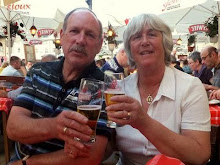Friday 10th August
Plenty of rain fell overnight which stayed with us well into mid-morning. The site we were on was only about 100 yds or so from the Dolaucothi mines and to make sure we got onto the first tour of the day at 10am, Ian offered to brave the rain to book the tickets at the office.
 |
| Last night and a BBQ, this morning and rain. |
By the time he returned the rain had all but stopped but having been told we had to get kitted up in hard hats and headlamps at least 15 minutes before the tour started, it was grab my coat and camera and follow him back.

Our guide was brilliant. Explained in great detail how between 70AD and 80 AD the Romans began the first extensive mining for gold at Dolaucothi, creating large open-cast workings and digging several tunnels. The mines were left unworked for over 1600 years after the Romans left and it was the Victorians and then the Edwardians that began mining again. Since then many other companies worked the mines throughout the 19th century and early 20th century until the mines finally closed in 1939 and in 1941 donated to the NT.
No artificial lighting in the mines so our headlamps were needed as were those hard hats. Very low ceilings and many a bang was heard as the taller of the group made contact with the rocks above.
 |
| The mining trucks are actually called Drams. Bottom R and the entrance to the mine |
 |
| Explaining about tallow candles. One per miner and when that ran out the miner returned to the top. To stop working sooner many a miner would nibble the bottom of the candle until that is, the bosses got wise to it and spread the rumour that arsenic had been added. |
 |
| Veins of quartz rocks with the possibility of gold. Bottom R one of the many adits (passages) |
 |
| A unique feature to these gold mines is the silver organism and small mushroom type fungi that grow on the walls and wooden posts. Only one other mine in the world can also claim these silver phenomena and that is in South Africa. |
Once the tour ended a question was asked if anyone had difficulty in ascending small and very tight spaces. If so a backup guide would take them out the way we had come. Everyone in the group said they were prepared for the squeeze and so he showed us to a small tunnel with rocky steps leading up. A beam across the entrance meant that about 4 ft diameter
was all one had to crawl through. We were the last to ascend. In front of us, a lady and her husband started the climb up. We followed and nearly halfway up the tricky rock section the lady lost her nerve completely desperately wanted to come down.
 |
| The husband of the lady who panicked |
 |
| Ian on his way up. Not long after I took this photo and we had to back up. |
The backup guide was still at the bottom and said she would take her the other way. But this meant both Ian and myself had to climb back down those rocks. Good job we had had some caving experience in New Zealand. We had to feel for any foothold, not easy without much light and unable to turn around. The backup guide then ascended to coax the lady down. Left alone Ian and I went for an explore.
BY the time the lady eventually made it back down we had been at the bottom for nearly 10 minutes. As soon as she was safely on terra Fermi, I took the lead and climbed to the top. I must say for anyone claustrophobic this would have been terrifying. Narrow with very high ledges to step onto as well as keeping your head down was bad enough and with one nearly touching the walls either side, I can fully sympathise with that lady.
 |
| Took these photos while we were waiting. Shows how narrow the exit was. |
After the mines, it was time to start the journey home. Going via the Elan valley we came across Caban Coch reservoir. Calling in at the visitor centre discovered that there the 5 dams and 4 reservoirs were built to provide clean water to Birmingham in the 19th century. So low were these reservoirs that I wondered about water rationing here. But helping out two fishermen at one of the dams who had forgotten to bring any water (filled his kettle for him so he could have a cup of tea) they told us that the levels had dropped by 40% and that these reservoirs were also necessary to keep the rivers flowing for the fish, especially the Brown Trout.
 |
| Caban Coch dam and reservoir |
 |
| Top left what looks like a viaduct is Carag Ddu Dam. The completely submerged dam which plays a vital role in maintaining a constant supply of water to Birmingham. Garreg Ddu holds water back on the upstream side so that water can always be extracted at the Foel Tower.(exert from Elan valley past and present) |
 |
| Claerwan Dam |
 |
| Craig coch Dam |
Having driven to most of them we took the mountain road and found a wonderful place to stop. Time was by now nearly 7pm and dinner was still to be prepared. But what a stop with only the sheep as our neighbours and the occasional car driving by. Skies are clear at the moment and as this is classed as a dark sky reserve, hoping for an abundance of stars.
And in flying in skies above























No comments:
Post a Comment